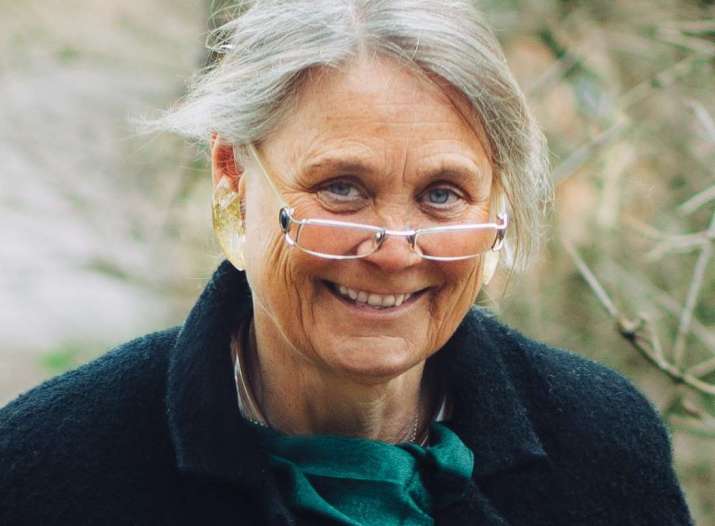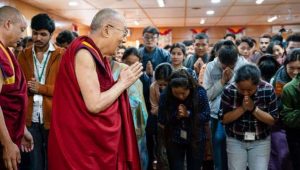
Nestled in the Himalayan foothills, just outside the town of Dehra Dun, India, lies the Tarab Ling retreat center. Residents of the center rarely venture outside after dusk. A leopard has been spotted roaming around and has recently taken prey, a small dog, leaving its mother inconsolable and the other dogs nervous.
So little wonder that, when night falls, the dogs are all scurrying for their hideouts. Some of them ask to be let into the student rooms. And if those who stay outside are heard barking at night, it is seen as a sign that the leopard is back.
Yet when morning arrives, the campus and the neighbouring Garhwal hills present a different image, draped in the golden winter sun.
At the centre, students discuss millennia-old Buddhist texts and their relevance to the world of Facebook and social media. They are led by Lene Handberg, a tall Danish lady in her sixties with a ready laugh. She also leads the meditations sessions.
The retreat centre takes its name from its inspirator; a Tibetan lama who was based in Denmark for most of his life; Tarab Rinpoche.
Recognized as a reincarnate lama at a young age, Tarab Rinpoche finished his academic training at the famed Drepung Monastery near Lhasa, Tibet. He had established a reputation for being a sharp scholar, even before he came to India in 1959, after the Chinese occupation. After a brief stay in India, he moved to Copenhagen to work at the Royal Danish Library.
At the time, Handberg was a student of psychology in her early twenties. She was restless and unhappy with what Western universities were teaching at the time. When she met Tarab Rinpoche, and what he had to share blew her away.
“I couldn’t believe my luck! From our first meeting we were deeply connected. And I felt a sincere commitment to his way of thinking, being, and the transformative practice of his lineage,” she says.

They worked together for 21 years until Rinpoche’s passing in 2004. They were so close that their families shared the same house in Copenhagen. Together, they toiled to present Buddhist philosophy in a manner that was accessible to all while remaining faithful to the ancient texts.
The end product of their collaboration, a Buddhist course, is dubbed “Unity in Duality,” which reflects the Buddhist idea of “dependent origination,” or the interdependent nature of reality (Skt: Pratityasamutpada).
The course package, presented in four main modules structured around four main schools of Buddhist philosophy: Sautantrika, Vaibhasika, Yogacarya, and Madhyamika, mirrors Rinpoche’s critical take on Buddhism.
“Tarab Rinpoche was not satisfied with mere belief. He had an investigative and explorative nature, which made it possible for him to give birth to Unity in Duality,” Handberg says.
These teachings are based on scholars from the ancient Buddhist University of Nalanda. The names of Indian fellows such as Vadubhandu, Asanga, Dharmakirti, and Nagarujuna might sound foreign to many, but they were pioneering philosophers.
According to Handberg, the course material can be applied in a wide range of areas, most notably psychology, psychotherapy, ethics, and, of course, in spiritual practice.
Not least because of his experience of having lived in the West for so long, Rinpoche’s teachings make a special effort in tackling the vagaries of modern culture, lifestyle, and modernity in general.
“In this sense, what Tarab Rinpoche was doing, was to make the knowledge of Buddhism accessible and useful for people of modern culture,” Handberg says.
As a result, the Buddhist knowledge presented in the Unity in Duality program is seen as useful for people from all walks of life. It has particular appeal for psychotherapists, counsellors, coaches and instructors, who often use the material in their own work.
It takes time for students to be conversant with the insights. The courses usually take four or five years to complete, and that is if students take them for 3–4 weeks a year. Many repeat the courses to make sure that they have truly understood its teachings. Even Buddhist monks often spend decades mastering them.
The program is currently taught in Scandinavian countries, and in France, Germany, Holland, and Slovakia. Plans are being made to offer it in the United States and in Asia, as well. The program also attracts students from Tibetan universities in India, who take the course as part of their curriculum.
During the daytime, students can be seen sipping tea on the lawn, during breaks. Monkeys look down from the rooftops, possibly eyeing the cookies. The layout of the retreat centre was inspired by Himalayan architecture (characterised by white-washed walls made of stone, with sloping roofs) and was designed by Handberg’s husband, an experienced architect. It blends into the rural landscape. It has not been an easy journey bringing the campus to fruition, however. There was, of course, the fundraising work, and then there were lawsuits from the locals and some difficult land dealers.
Handberg’s practicality and common sense is hard to miss when you visit. A new group had just arrived at Tarab Ling, some of them with their kids. And much to her chagrin, Handberg had seen the toddlers playing and roaming around the campus even late into the night. She once heard that a leopard had attacked children in the neighboring villages.
So the next morning, she was seen busily instructing the staff to warn the parents. She is not going to let any accident—let alone a leopard attack—bring down her hard-won spiritual retreat.
See more











